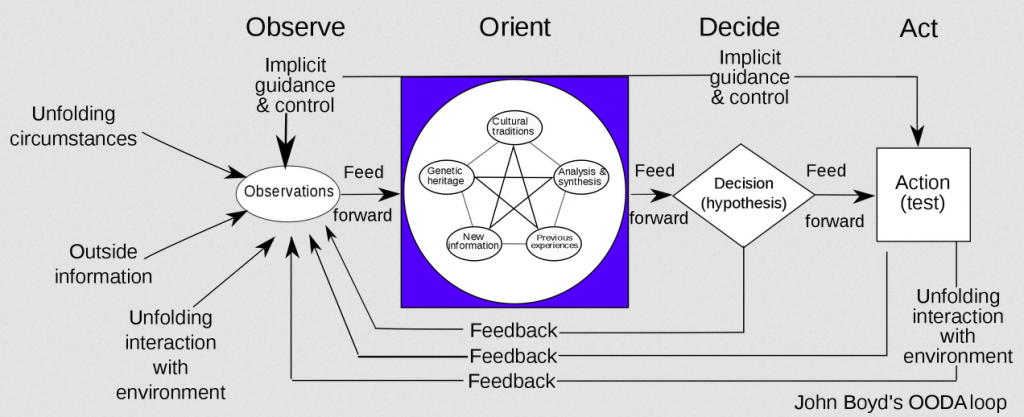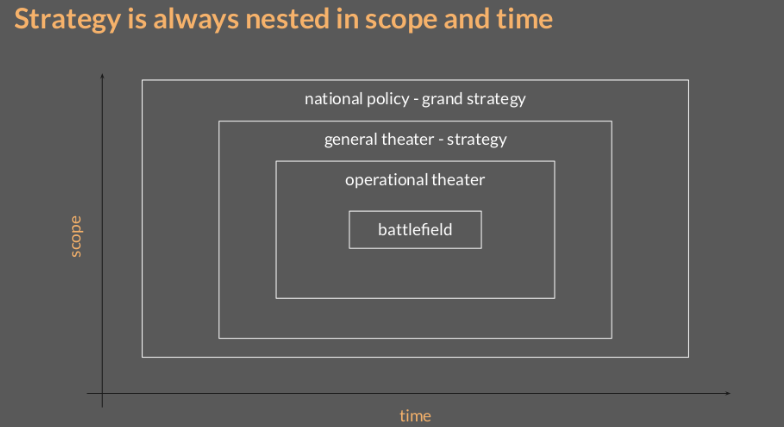by Nick Kalogirou
This is Part 2 of a series. Part 1: Pursuing Responsible Analytics.
What is strategy?
Strategy is derived from the Greek word “strategos” – the skill of a general.
In a military context, a general is trying to achieve a goal while being surrounded by the fog of war (ignorance). Not only is the general trying to select a promising path with limited information, they are also trying to continually learn, in order to adapt to changing circumstances, changing goals, and often a dynamic and intelligent adversary.
Think about the various operational theaters (domains) that a general must consider in modern warfare. Most people can label sea, air, and land. But modern warfare must consider new facets of both threats and opportunities – like cyber warfare, and human/psychological warfare. Maneuvering in all domains to a position of relative advantage requires joint integration. A general who can understand and coordinate across different domains can preserve a good possible range of options going forward. With options comes reduction of risk and the flexibility to use limited resources for maximum impact.
A general at war is not looking at specific operations and tactics, but rather the streams of information coming in from different domains and higher levels. Higher levels contain information about longer term implications and consequences. The saying ‘lose the battle but win the war’ can be interpreted as having an understanding of the larger context forces at play which may supersede the operational level.
The art of strategy lies in paying attention to the right information, at the right level, at the right time. There is a continual evaluation of multiple paths that new information sheds light on. The unfolding circumstances feed into multiple models (Fig 1) of how the general thinks reality will play out. Incoming observations help prove and disprove various developmental paths, all aimed at the same strategic goal. As more information streams in, new hypotheses may be created, Action (or inaction) ultimately follows, feeding back into the unfolding situation. In this way strategy is more a process rather than an end point.

In business, strategies follow the same principles but are largely centered around economic goals. The competitive landscape is constantly shifting, so businesses try to orient themselves to garnering the right data to feed into the right analytics. Extracting the pros and cons patterns along multiple paths set the stage for a hypothesis and an action.
A business trying to outwit its competitors might determine with analytics that it could be more successful by acquiring and merging with the capabilities of many different companies (horizontal integration), vs developing in-house capacity and expertise (vertical integration). As the situation continually unfolds, the business entity strategically tries to match and maximize limited capacities to the challenges of the environment and adversaries.
If we know the strategy, what is the process that informs what the strategic goal should be?
What is grand strategy?
Grand strategy is the means by which long term objectives will be achieved. Long term objectives (the timeframe could be in years, or even generations) interact with the long term arcs of a wide range of external forces – e.g. political, economic, environmental, and even planetary forces.

“While the horizon of strategy is bounded by the war, grand strategy looks beyond the war to the subsequent peace.”
Liddell Hart
What is the sustainable, long term objective of the direction of a nation or organization? When we start asking questions like this, we have to clarify the motivations which lie behind strategy. In the context of war, the motivation comes from national policy foundations, and the desire for a nation to continue its existence and thriving (what is desired after the war in peacetime?). Likewise in a business, the motivation is the continued existence and operation of a corporation in its long term economic context.
Sustaining corporate power in the service of shareholder return is a very common motivation for large businesses. To upkeep this economic motivation over the long term, such as for pension plans for multiple generations of investors, businesses must act and adapt in non economic domains, such as the environmental and the political. However tensions can easily arise between the long term economic objectives of a corporation and the well-being of the political, social, and environmental context if the core business activities are not in sustainable alignment. Lobbying for favorable monopolistic conditions is a classic business grand strategy battleground which can be highly problematic outside the economic context.
When we start asking enough questions about grand strategy, we inevitably run into questions of purpose. What is the purpose of this organization / entity over the long term? And how much of our purpose needs to be aligned with the systems that gave rise to the entity in the first place?
Pursuing grand strategy requires thinking and acting on the long term relationships and responsibilities between an entity, the intelligent adversaries it faces, and its environment. The pursuit of these questions is shaped by individual and collective values, beliefs, and stories.
Values, Beliefs, and Stories
Values are intertwined with beliefs and stories. We learn what to value, what to believe, and how to act from experiences that are patterned into stories. These stories range from the personal to cosmic – and help us make sense of the world. Individual, cultural, and life stories can both help and hinder, depending on their match to the unfolding situation.
The stories that guide us can be pinned at different levels, and often can conflict with one another. One common example is that individuals and their organizations must balance the personal level with the group level. A soldier may have a family to care for, but may put their life at risk by fighting for their troop or nation. We are individuals and have personal responsibilities, but also are part of larger groups which also carry responsibilities. There are stories which emphasize the individual responsibility, but also stories which emphasize the collective responsibilities.
Values like humility, caring, compassion, power, kindness, and good will, can span the spectrum from the individual to the broadest reaches of the planet, life, and humanity. They inform our character and conduct as we go about executing strategy. Similarly, the absence of these values also affects our strategies. The story of economic entities externalizing the costs of their business to the environment is a common example of prioritizing economic values to the exclusion of values of care for our home planet.
Stories and values are not necessarily wise and/or responsible. Wisdom is not a guarantee even if we ask questions of grand strategy. So how do we judge whether our stories and values are aligned with the long term objectives of a nation, a business, humanity, and life on this planet?
Ethics, Briefly
Ethics gives us the chance to reason about appropriate conduct (moral reasoning) in challenging situations.
These are some hard, but not impossible ethical questions:
- What is the common good?
- What is our responsibility to the common good?
- What is progress? Individually, as a society, as humanity
- What’s the gap between our espoused values and values in action? Is that an acceptable gap?
- Should organizations (like corporations) align their goals with other societal systems, life systems, and planetary systems?
- What values in action matter to us as we work towards our goals? Does it matter who we are as we work?
Debating and discerning the right actions at different levels based on values is the realm of ethics.
Working through questions like this informs what values and stories to live by – which informs our grand strategies – which informs our strategy. All three of these hold great potential for achieving both long and short term objectives.
Ethical thinking and action is possible – we’ve had millennia of practice taking different approaches. In the next article, I will dive a little deeper into exploring the role of ethics in pursuing responsible strategy.
References
Henry, J. (2017). Ships in fog [Photograph]. Flickr. https://www.flickr.com/photos/jjwhenry/36474580784/
Grand strategy. (2021, Jul 15). In Wikipedia. https://en.wikipedia.org/wiki/Grand_strategy
Grand strategy. (2020, Aug 17). Retrieved Jul 15, 2021, from https://thestrategybridge.org/the-bridge/2020/8/17/defining-grand-strategy
OODA Loop. Retrieved Jul 15, 2021, from https://en.wikipedia.org/wiki/OODA_loop
Low, K. (2016). The Human Venture Institute mapbook (16th edition). Action Studies Institute.
Suggested Resources
- Smarter Every Day: The future of war and how it affects you – multi domain operations
- The Mystery and Mastery of Strategic Thinking, by Dana Penrice, humanventure.com blog
- Range (2019) by David Epstein
- Other presentations and resources by Nick Kalogirou
- Recommended books by the Human Venture Institute
- Human Venture Meta Framework
- Map 66: Biosocial Horizon Lines – boundaries of caring
- Map 69.1: Frames of Action – tactics to grand strategy
Nick Kalogirou is a Human Venture Leadership alumnus who likes to put technology, ethics, and communication together into understandable and useful stories. This article and other insights can be found on his website, nickkal.com

